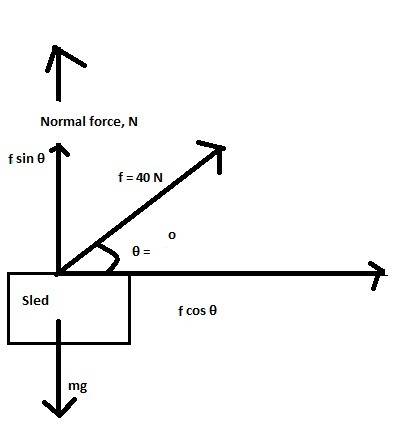
Physics, 29.12.2019 15:31 Daisysolis136
Jake drags a sled of mass 18 kg across the snow. the sled is attached to a rope that he pulls with a force of 70 n at an angle of 40°. if there is no friction, what is the normal force acting on the sled?

Answers: 2


Other questions on the subject: Physics

Physics, 21.06.2019 14:00, scottytohotty
Apositive rod is placed to the left of sphere a, and the spheres are separated. which best describes the spheres? sphere a is negative and sphere b is positive because protons from sphere a are attracted to the rod and move to sphere b. sphere a is negative and sphere b is positive because electrons from sphere b are attracted to the rod and move to sphere a. sphere a is positive and sphere b is negative because electrons from the rod move to sphere b and protons then move to sphere a. sphere a is positive and sphere b is negative because protons move from sphere b to the rod and also to sphere a.
Answers: 1

Physics, 22.06.2019 02:10, kernlife
Astudent is performing an experiment comparing sound and light waves. the student gathers the following data. what conclusion does the student most likely make based on this data? light waves always travel the same speed; however, the speed of sound is determined by the medium that it travels through. all sound waves always have the same energy, so the temperature of the medium does not affect wave speed. light needs to vibrate particles, so it travels fastest in tightly packed solids, while sound does not need a medium, so it travels fastest in a gas. tightly packed particles in solids slow down the light waves; however, sound waves make particles bounce into each other, so they travel faster in solids.
Answers: 3


Physics, 22.06.2019 15:00, ttorres013
Consider a uniformly charged ring in the xy plane, centered at the origin. the ring has radius a and positive charge qdistributed evenly along its circumference. a)what is the direction of the electric field at any point on the z axis? . b)what is the magnitude of the electric field along the positive z axis? use k in your answer, where k=14πϵ0. d)the ball will oscillate along the z axis between z=d and z=−d in simple harmonic motion. what will be the angular frequency ω of these oscillations? use the approximation d≪a to simplify your calculation; that is, assume that d2+a2≈a2. express your answer in terms of given charges, dimensions, and constants
Answers: 2
You know the right answer?
Jake drags a sled of mass 18 kg across the snow. the sled is attached to a rope that he pulls with a...
Questions in other subjects:

English, 24.06.2019 00:00
















